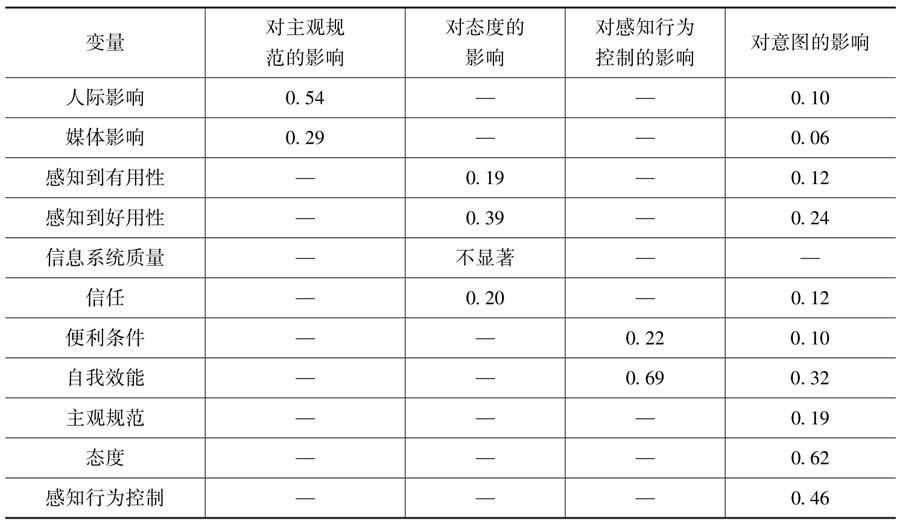- 國家戰(zhàn)略與政府治理現(xiàn)代化
- 章文光
- 1692字
- 2020-05-13 15:27:40
第三節(jié) 結(jié)論與對策建議
一、結(jié)論
從網(wǎng)上大廳的模型中可知,各個變量因素對于意圖的影響主要分為三個層面,即主觀規(guī)范、態(tài)度和感知行為控制層面。
表1-5 各變量之間的影響效果

在結(jié)果討論之前,有必要對網(wǎng)上大廳的使用背景進行簡要概述。公眾可以根據(jù)自己的時間和地點隨意選擇,主動權(quán)較大,并且網(wǎng)上大廳的號源可以滿足公眾需求,號源充足。充分了解公眾較大的選擇權(quán)以及號源的充足性,是討論網(wǎng)上大廳模型的前提條件。
對意圖影響最大的因素是自我效能和感知到好用性。網(wǎng)上大廳使用簡單,公眾的自主選擇權(quán)較大,且號源充足,使用的自信程度以及較大的自主選擇權(quán)會促使公眾產(chǎn)生使用意圖。通過網(wǎng)上大廳的預受理,可以減少排隊等待時間,減少所花費的精力,讓用戶感受到系統(tǒng)的好用性。
感知到有用性和信任的影響力次之。號源的充足性以及用戶較大的選擇權(quán),使得用戶認為即使不用網(wǎng)上大廳,通過現(xiàn)場排隊的方式也可以進行辦理,用戶對于網(wǎng)上大廳的有用性感受并不強烈。此外,由于公眾對于公安部門的信任,愿意嘗試網(wǎng)上大廳,所以也成為影響意圖的關(guān)鍵因素。
便利條件對于意圖的影響力表明,用戶對于條件的便利程度較重視。大多數(shù)證件辦理者辦理時間充裕,在不耽誤行程的前提下,并不在乎是否能提前一兩天辦理完成,所關(guān)注的是在辦理過程中能否順暢地完成手續(xù)。
與其他因素相比,人際影響和媒體影響對于意圖的影響力較小。由于出入境人群屬于少數(shù),所以沒有得到公眾的普遍關(guān)注,也沒有得到媒體的廣泛宣傳,并不是公眾的熱點問題,所以人際影響和媒體影響對于意圖的影響力較小。
信息系統(tǒng)質(zhì)量對于意圖的影響不顯著,這也反映了一個客觀問題:北京市在線公共服務(wù)發(fā)展水平不及歐美等發(fā)達國家。用戶對于在線公共服務(wù)的體會仍處在實用性階段,而對于整體風格、人性化水平等信息系統(tǒng)質(zhì)量的關(guān)注程度并不高,這也真實地反映了我國電子政務(wù)發(fā)展仍處于初級階段的客觀事實。
二、對策建議
基于數(shù)據(jù)分析結(jié)果,本文提出以下三點建議。
第一,了解用戶需求。在各大城市中,傳統(tǒng)的出入境管理方法已經(jīng)不能滿足現(xiàn)代化的生活和工作方式,因此建立網(wǎng)上大廳,使得公眾充分體驗其優(yōu)勢,這是行政許可在線公共服務(wù)未來的發(fā)展方向。同時,政府部門應(yīng)該根據(jù)用戶需求,逐步提升服務(wù)質(zhì)量,使之更為貼合用戶需求。網(wǎng)上大廳為用戶提供了方便,也為北京市公安局的出入境管理工作帶來了新的活力。
第二,增強宣傳力度。在網(wǎng)上大廳中增加分享鏈接,增加網(wǎng)絡(luò)的可見度是必要的新媒體措施。這可以增加公眾對于網(wǎng)上大廳的了解,由于親友的推薦也會增加公眾的認同感。此外,作為服務(wù)終端的各個分局辦理點,應(yīng)為沒有使用過網(wǎng)上大廳的用戶發(fā)放宣傳手冊,明確介紹優(yōu)勢特點與使用方法,通過優(yōu)化終端服務(wù)進一步增加公眾的可見性,促進用戶的接受和使用。
第三,增加便利性。開發(fā)手機APP軟件適應(yīng)年輕人的操作習慣,是在線公共服務(wù)值得借鑒的做法。此外,及時了解用戶的使用情況,優(yōu)化現(xiàn)場服務(wù)流程,也是促進便利條件的積極方式。
(1) 國務(wù)院.2006至2020年國家信息化發(fā)展戰(zhàn)略[EB/OL].http://news.xinhuanet.com/newscenter/2006-05/08/content_4522878.htm.
(2) Davis F D, Richard P B, Paul R W: User Acceptance of Computer Technology: A Comparison of Two Theoretical Models [J] Management Science, 1989, 35 (8): 982-1003.
(3) Fishbein M, Ajzen I. Belief, Attitude, Intention and Behavior: An Introduction to Theory and Research [M] . MA: Addison-Wesley, 1975.
(4) A lexander J B, Anand J, Ryan G W. Content Acceptance Model and New Media Technologies [J] Journal of Computer Information Systems, 2013, Spring: 56-64.
(5) Anol B, Clive S. Influence Processes For Information Technology Acceptance: An Elaboration Likelihood Model [J] MIS Quarterly, 2006, 30 (4): 805-825.
(6) Brett J L, Rodger G, Sandra H. Measuring Student Perceptions of Blackboard Using the Technology Acceptance Model [J] Decision Sciences Journal of Innovative Education, 2006, 4 (1): 87-99.
(7) Chao M C, Hua Y L, Szu Y S, et al. . Understanding customers’loyalty intentions towards online shopping: an integration of technology acceptance model and fairness theory [J] Behavior & Information Technology, 2009, 28 (4): 347-360.
(8) Chih C W, Shao K L, Wen C F [J] Extending the technology acceptance model to mobile telecommunication innovation: The existence of network externalities [J] Journal of Consumer Behavior, 2008 (7): 101-110.
(9) Ajzen I. The Theory of Planned Behavior [J] Organizational Behavior And Human Decision Processes, 1991 (50): 179-211.
(10) Leo A G, Peter K. The influence of cost on medical prescriptions: A comparison of the theory of planned behavior and the composite attitude behavior model [J] . International Journal of Medical Marketing》, 2002, 2 (4): 311-327.
(11) Paul A P, Mendel F. Understanding And Predicting Electronic Commerce Adoption: An Extension Of The Theory Of Planned Behavior [J] . MIS Quarterly, 2006, 30 (1): 115-143.
(12) Danielle B F, Katherine M W. The Role of Self-Efficacy in Predicting Rule-Following Behaviors in Shelters for Homeless Youth: A Test of the Theory of Planned Behavior [J] . The Journal of Social Psychology, 2006, 146 (3): 307-325.
(13) Lee Y H, Kozar K A, Larsen K T. The technology acceptance model: Past, present and future [J] . Communications of the Association for Information Systems, 2003 (12): 752-780.
(14) Hung S Y, Chang C M, Yu T J. Determinants of user acceptance of the e-Government services: The case of online tax filing and payment system [J] . Government Information Quarterly, 2006 (23): 97-122.
(15) DeLone W H, McLean E R. The DeLone and McLean model of information system success: A tenyear update [J] . Journal of Management Information Systems, 2003, 19 (4): 9-30.
(16) Jaeho H, Ingoo H. Performance measure of information system in evolving computing environment: A empirical investigation [J] . Information & Management, 2003 (40): 243-256.
(17) Bandura A. Self-Efficacy Mechanism in Human Agency [J] . American Psychologist, 1982, 37 (2): 122-147.
(18) Taylor S, Todd P A. Understanding information technology usage: A test of competing models [J] . Information Systems Research, 1995, 6 (2): 144-176.
- 先進制造業(yè)文化:中國制造業(yè)轉(zhuǎn)型升級的必由之路
- 促進就業(yè)為取向的宏觀調(diào)控政策體系研究
- “N-X”合作機制與早期收獲項目:以孟中印緬經(jīng)濟走廊建設(shè)為例
- 全球風口:積木式創(chuàng)新與中國新機遇
- 世界級城市群視閾下的天津發(fā)展
- 信息與通信技術(shù)促進中國經(jīng)濟轉(zhuǎn)型和低碳發(fā)展研究
- 吳易風經(jīng)濟思想評說(第二輯)
- 中國傳統(tǒng)經(jīng)濟思想經(jīng)典文選(傳統(tǒng)經(jīng)典文獻導讀叢書)
- 財政支出、居民消費與財政政策選擇
- 雙循環(huán):構(gòu)建“十四五”新發(fā)展格局
- 中國北方沿海地區(qū)生態(tài)經(jīng)濟區(qū)劃研究
- 中國的綠色發(fā)展之路(英文)
- 長江經(jīng)濟帶綠色發(fā)展報告(2017)
- 生態(tài)優(yōu)先原則下的土地利用規(guī)劃技術(shù)研究
- 2016年政府工作總體要求和經(jīng)濟社會發(fā)展主要預期目標